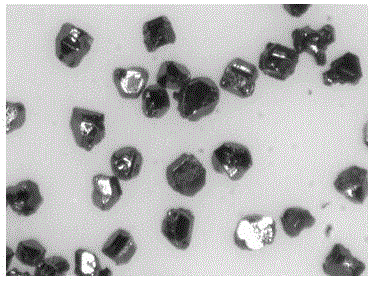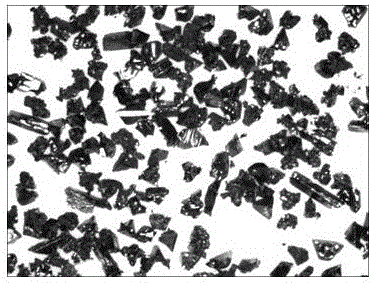Preparation method for copper-iron-zinc-tin-sulfur micron monocrystal particles
A technology of copper-iron-zinc-tin-sulfur and single-crystal particles, which is applied in the fields of final product manufacturing, sustainable manufacturing/processing, photovoltaic power generation, etc., can solve the difficulties in the preparation and performance optimization of high-efficiency thin-film batteries, and the difficulty in growing large-size single-crystal particles and other issues, to achieve the effects of easy industrial production, improved utilization, and advanced optical characteristics
- Summary
- Abstract
- Description
- Claims
- Application Information
AI Technical Summary
Problems solved by technology
Method used
Image
Examples
Embodiment 1
[0035] Weigh 10mmol CuS, 1.5mmol FeS, 3.5mmol ZnS, 5mmol SnS and 50mmol CsI of the flux as the reaction raw materials, mix them and grind them thoroughly to make them evenly mixed; put the mixed samples into a quartz bottle, and use a vacuum pump unit to evacuate to 10-10 2 Pa (can also be protected with an inert gas), so as to eliminate the influence of air on the molten salt reaction, seal the quartz bottle with an oxyhydrogen flame; place the sealed quartz bottle with the mixed sample in an ordinary heating furnace from normal temperature to 800 Keep at ℃ for 72 hours, then cool down to 600℃, take out the quartz bottle and quickly cool it down to room temperature (put it in water); finally take out the sample in the quartz bottle, wash it with ultrasonic water several times to remove the flux CsI, and then put the sample in a drying oven at 80℃ After drying for 2 hours, black particles with crystalline luster on the surface were obtained, and finally the obtained sample was ...
Embodiment 2
[0038] Weigh the reaction raw materials 10mmolCu, 3.5mmolFeS, 1.5mmolZn, 5mmolSn, 18mmolS and flux 60mmolCsCl, mix and grind thoroughly to make it evenly mixed; put the mixed sample into a quartz bottle, and use the vacuum pump unit to evacuate to 10-10 2 Pa (can also be protected with inert gas), so as to eliminate the influence of air on the molten salt reaction, seal the quartz bottle with an oxyhydrogen flame; place the sealed quartz bottle with mixed samples in an ordinary heating furnace and heat it from normal temperature to 750 Keep the temperature at ℃ for 72 hours, then cool down to 600℃, take out the quartz bottle and quickly cool it down to room temperature (put it in water); finally take out the sample in the quartz bottle, wash it with ultrasonic water several times to remove the flux CsCl, and then put the sample in a drying oven at 80℃ After drying for 2 hours, black particles with crystalline luster on the surface were obtained, and finally the obtained sample ...
PUM
 Login to View More
Login to View More Abstract
Description
Claims
Application Information
 Login to View More
Login to View More - R&D
- Intellectual Property
- Life Sciences
- Materials
- Tech Scout
- Unparalleled Data Quality
- Higher Quality Content
- 60% Fewer Hallucinations
Browse by: Latest US Patents, China's latest patents, Technical Efficacy Thesaurus, Application Domain, Technology Topic, Popular Technical Reports.
© 2025 PatSnap. All rights reserved.Legal|Privacy policy|Modern Slavery Act Transparency Statement|Sitemap|About US| Contact US: help@patsnap.com



